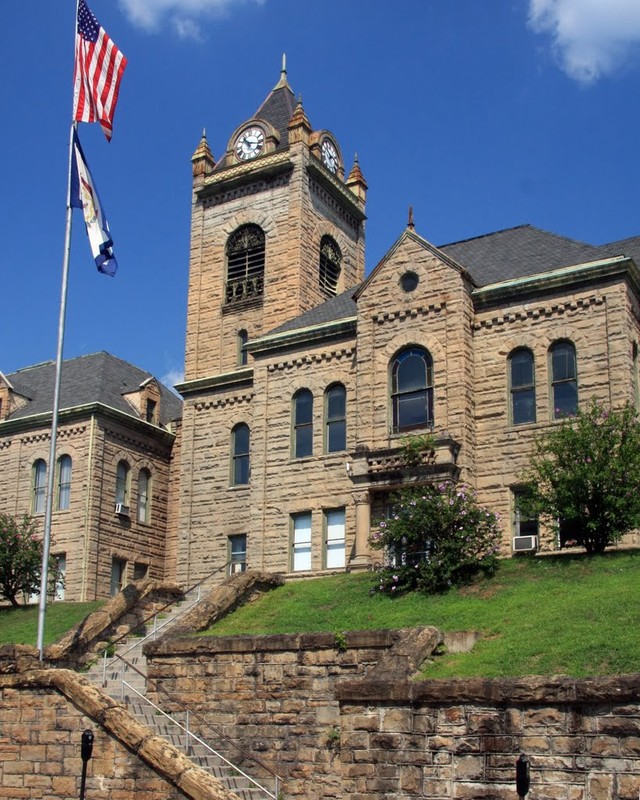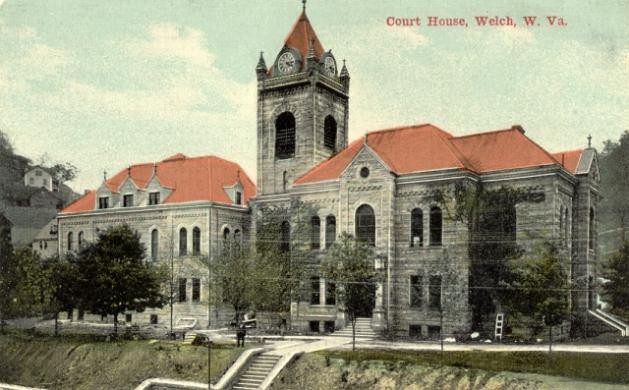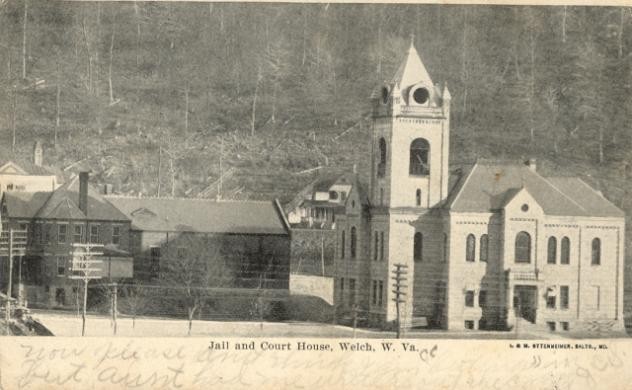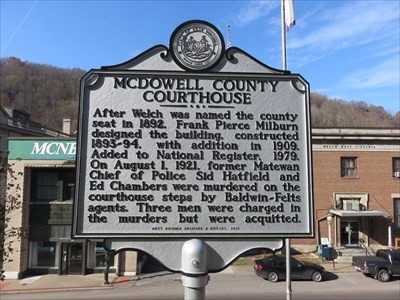McDowell County Courthouse
Introduction
Text-to-speech Audio
Images
The McDowell County Courthouse

Postcard of the Courthouse.

Postcard of the Courthouse

WV Historical Marker

Backstory and Context
Text-to-speech Audio
The McDowell County Courthouse in Welch, West Virginia, is located on a hillside next to Wyoming Street overlooking downtown. The building was designed in 1893 by Frank Milburn Pierce and represents Romanesque Revival style architecture. According to West Virginia Division of Culture and History, “Buildings constructed in this style exhibit elements taken from the Greek Revival style, but also incorporate round arches on windows and entrances, heavy masonry piers and richly decorated cornices” (WVDCH, wvculture.org). The most notorious aspect of the building, however, are the steps to the courthouse, which are infamously associated with the murders of Sid Hatfield and Edward Chambers by Baldwin & Felts detective agents.
Sid Hatfield was a well-known labor leader and union organizer from Mingo County. He was Chief of Police at Matewan and nicknamed the ‘Miners’ Hero.’ He is renowned for spurring the Matewan Massacre and killing two Baldwin & Felts agents during the event. Edward Chambers, friend of Matewan mayor C.C. Testerman and a Matewan native himself, was the president of the county court. Together, Hatfield and Chambers worked to unionize the southern Appalachian coalfields.
On August 1, 1921 Hatfield and Chambers arrived at the Welch Depot to stand trial for a shooting incident that occurred at the mining camp of Mohawk in McDowell County. Baldwin-Felts mine guards, headed by ‘Buster’ Pense, Bill Salter, and Everett Lively, flanked the courthouse as they waited for Hatfield and Chambers, accompanied by their wives, to reach the building. Once they had arrived, the trio of deadly gunmen began firing at the unsuspecting Matewan men. One mine guard, Hughey Lucas, “turned and fired a number of shots against the stone wall of the courthouse to make it appear that Hatfield and Chambers were armed and had fired first at the mine guards, but missed” (Lee, Bloodletting in Appalachia, 68). Hatfield had been pierced by four bullets while Chambers had been shot three times, both died instantly. Miraculously the defendants were acquitted on the grounds of self-defense. This event shows how coal operators and anti-unionists dominated southern West Virginia government during the early nineteenth century.
Although the killings had been witnessed by several bystanders, Welch citizens, fearful of the mine guards’ retribution, remained silent. According to Howard B. Lee, author of Bloodletting In Appalachia, the killings “were carefully planned and deliberately carried out by the mine guards, with the connivance of certain county officials. Lee believes that the trials of the killers were little more than a farce, staged for the sole purpose of acquitting them. Unfortunately, Hatfield and Chambers were the victims of private vengeance and had to pay the price for their part in the Matewan Massacre. Today, both McDowell and Mingo County residents continue to debate the outcome of the fateful incident that occurred on the steps of the McDowell County courthouse.
Sources
Bailey, Rebecca J. Matewan Before the Massacre: Politics, Coal, and the Roots of Conflict In A West Virginia Mining Community. Morgantown: West Virginia University Press, 2008. Matewan Before the Massacre provides an in-depth look at the social, economic, and political problems that plagued the southern West Virginia coalfields during the early twentieth century. Bailey examines the UMWA origins in “Bloody Mingo” and the events that lead up to the deadly massacre. Her sources include oral histories, newspapers, and government documents. Lee, Howard B. Bloodletting In Appalachia: The Story of West Virginia’s Four Major Mine Wars and Other Thrilling Incidents of its Coal Fields. Parsons, West Virginia: McClain Printing Company, 1969. Bloodletting In Appalachia takes a look at four West Virginia regions that suffered from mine wars: Cabin Creek and Paint Creek, Tug Valley, Logan, and Monongahela. In each of these areas, Lee examines the conflicts between coal operators and their miners. His sources include newspapers articles, testimonies, photographs, and government documents. “McDowell County, Wyoming Street, Welch.” West Virginia Division of Culture and History. http://www.wvculture.org/shpo/ch/mcdowell.html (accessed October 14, 2014). The West Virginia Division of Culture and History is an expansive website offering vast historical information about the Appalachian state. The site’s mission is to identify, preserve, protect, promote and present the ideas, arts and artifacts of West Virginia’s heritage. “Romanesque Revival (1845-1875, later in West Virginia).” West Virginia Division of Culture and History. http://www.wvculture.org/shpo/ch/styles.html (accessed October 14, 2014).
"Sid Hatfield/McDowell County Courthouse." Waymarking.com. Accessed October 1, 2020. https://www.waymarking.com/waymarks/WMZM06_Sid_Hatfield_McDowell_County_Courthouse.
